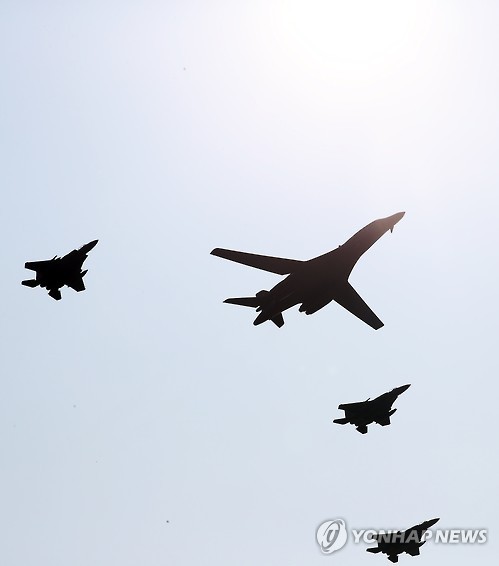The flight by two U.S. B-1B bombers over South Korea demonstrates the “steadfast and unshakable” U.S. commitment to its key Asian ally in the wake of North Korea‘s nuclear test, the U.S. Forces Korea commander (USFK) said Tuesday.
The supersonic bombers left U.S. Andersen Air Force Base in Guam on Tuesday morning and arrived over the skies above the Osan Air Base, south of Seoul, at 10:00 a.m.
They flew past the U.S. air base in Pyeongtaek, 70 kilometers south of Seoul, accompanied by a flight of four South Korean F-15K and four U.S. F-16 fighter jets. The flybys highlight the close cooperation between the U.S. and South Korean military forces that keeps them ready to respond at any time to threats, the USFK said.
“North Korea’s nuclear test is a dangerous escalation and poses an unacceptable threat. The United States has an unshakable commitment to defend allies in the region and will take necessary steps to do so, including operations like this one today, and the deployment of the Terminal High Altitude Air Defense (THAAD) battery to the Korean Peninsula,” USFK Commander Gen. Vincent K. Brooks told reporters at Osan Air Base.
“Today‘s demonstration provides just one example of the full range of military capabilities in the deep arsenal of this strong alliance to provide and strengthen extended deterrence,” he said.
Joint Chiefs of Staff Chairman Lee Sun-jin said, “As we warned multiple times, if North Korea continues its aggressive behavior and develops nuclear weapons, it will meet retaliatory actions that will shake the very foundation of the regime’s existance.”
The two generals also said the alliance military forces remain ready to meet mutual defense obligations against threats to the security of the Korean Peninsula and the Indo-Asia-Pacific region.
 |
Photo taken on Sept. 13, Joint Chief of Staff Chairman Lee Sun-jin (second from left) and USFK Commander Gen. Vicent K. Brooks (third from left) stand together at Osan Air Base in Pyeongtaek. (Yonhap) |
In recent years, Pyongyang has escalated its saber-rattling despite warnings issued by the international community. On Friday, it detonated its fifth nuclear device in the face of strong opposition to its weapons of mass destruction programs.
The U.S. has in the past taken a series of military counteractions following major provocations by the North.
On Jan. 10, four days after the North conducted its fourth nuclear test, the U.S. sent a B-52 Stratofortress strategic bomber
to the skies above the same air base as a show of force. The bomber can be armed with nuclear missiles and “bunker buster” bombs that are capable of destroying the North‘s hardened underground facilities.
 |
Photo taken on Sept. 13, shows a B-1B bomber (center left) flying accompanied by three F-15K fighter jets over the skies of the Osan Air Base in Pyeongtaek, 70 km south of Seoul. (Yonhap) |
In August, the U.S. Air Force forward deployed the B-1B bomber in the U.S. Pacific Command’s Andersen Air Force Base on Guam partly to better counter the North‘s evolving nuclear and missile threats.
The B-1B Lancer is a four-engine supersonic variable sweep wing, strategic bomber with a max speed of Mach 2.0 and is capable of flying very close to the ground to avoid detection as it closes in on its target. It first went into operation in the U.S. Air Force in the 1980s and can carry conventional guided bombs, such as the GBU-38 and the GBU-54.
The bomber, which costs $137 million per unit, can reach Pyongyang within two hours after it leaves the Guam base.
The flyover, meanwhile, was originally scheduled on Monday but postponed due to “inclement weather conditions” in Guam, the USFK said. (Yonhap)









